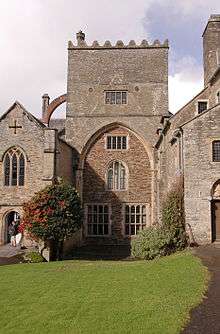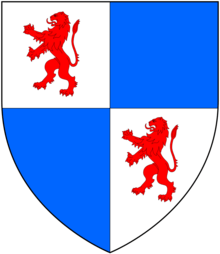Sir Francis Drake, 3rd Baronet
Sir Francis Drake, 3rd Baronet (1642–1718), of Buckland Abbey in the parish of Buckland Monachorum and of Meavy, both in Devon, England, was elected seven times as a Member of Parliament for Tavistock in Devon, in 1673, 1679, 1681, 1689, 1690, 1696 and 1698.

Origins
He was baptised on 1 May 1642, at Buckland Monachorum, the eldest surviving son and heir of Thomas Drake (born 1620), a major in the cavalry of the Parliamentarian forces during the Civil War, the second son of Sir Francis Drake, 1st Baronet (1588-1637) (nephew of Admiral Sir Francis Drake (1546-1596)) and younger brother of Sir Francis Drake, 2nd Baronet (1617-1661). His mother was Susan Crimes, a daughter of William Crymes, of Buckland Crymes and a sister of Elisha Crymes MP.[1]
Career
He succeeded to the baronetcy on the death of his uncle Sir Francis Drake, 2nd Baronet on 6 June 1661.[2] He matriculated at Exeter College, Oxford on 3 June 1663, aged 16 and was awarded MA on 28 September 1663.[3] In 1673 he was elected a Member of Parliament for Tavistock in Devon, in a by-election to the Cavalier Parliament. He was re-elected for Tavistock in 1679, 1681, 1689, 1690, 1696 and 1698.[4] He purchased the manor of Meavy in Devon, and resided at the manor house west of St Peter's Church, in which survives the "Drake Aisle" or manorial chapel. The external stonework is inscribed with the date "1705" and the "Drake star" from his coat of arms.[5]
Marriages and children

Drake married three times, with children only from his third wife:
- Firstly on 6 February 1665, at Bere Ferrers in Devon, to Dorothy Bampfylde (d.1679), a daughter of Sir John Bampfylde, 1st Baronet of Poltimore House in Devon, by his wife Gertrude Copleston, daughter of Amyas Copleston of Warleigh in the parish of Tamerton Foliot, near Bere Ferrers. She died childless and was buried at Buckland on 30 January 1679.
- Secondly, by licence dated 21 October 1680, he married Anne Boone (d.1685), daughter of John Boone of Mount Boone, Devon, a Member of Parliament for Dartmouth in Devon. She died childless and was buried on 22 December 1685 at Buckland.
- Thirdly, by licence dated 17 February 1690, he married Elizabeth Pollexfen (d.1717) (buried on 25 March 1717, at Meavy[2]), a daughter and eventual co-heiress of Sir Henry Pollexfen, of Nutwell Court in Devon, Lord Chief Justice of the Common Pleas, by whom he had seven sons and one daughter, including:
- Sir Francis Drake, 4th Baronet (1694-1740), of Buckland Abbey and Nutwell, eldest son and heir.
Death
He died at the age of about 75 at Meavy where he was buried on 15 January 1718.[2]
References
- Vivian, Lt.Col. J.L., (Ed.) The Visitations of the County of Devon: Comprising the Heralds' Visitations of 1531, 1564 & 1620, Exeter, 1895, p.301, pedigree of Drake
- George Edward Cokayne Complete Baronetage, Volume 1 1900
- 'Alumni Oxonienses, 1500-1714: Disbrowe-Dyve', Alumni Oxonienses 1500-1714 (1891), pp. 406-439. Date accessed: 23 June 2012
- History of Parliament Online - Drake, Sir Francis, 3rd Bt.
- http://www.meavy.org.uk/fsp/history.htm
| Parliament of England | ||
|---|---|---|
| Preceded by Lord Russell George Howard |
Member of Parliament for Tavistock 1673–1685 With: Lord Russell 1673–1679 Lord Edward Russell 1679–1681 |
Succeeded by Sir James Butler John Beare |
| Preceded by Sir James Butler John Beare |
Member of Parliament for Tavistock 1689–1695 With: Lord Robert Russell |
Succeeded by Lord Robert Russell Lord James Russell |
| Preceded by Lord James Russell Ambrose Manaton |
Member of Parliament for Tavistock 1696–1701 With: Lord James Russell |
Succeeded by Lord James Russell Lord Edward Russell |